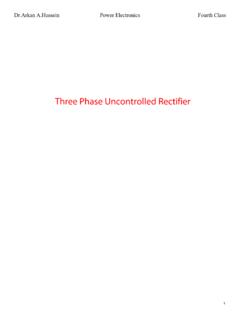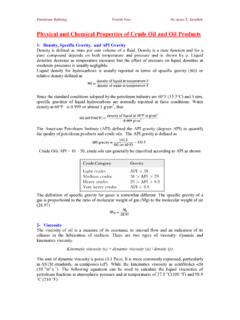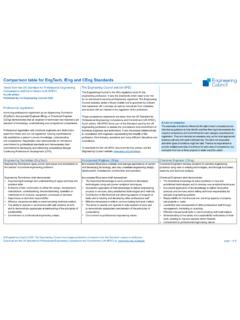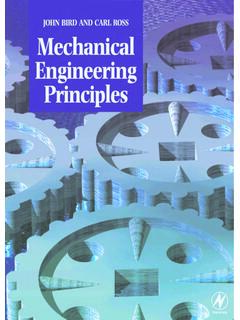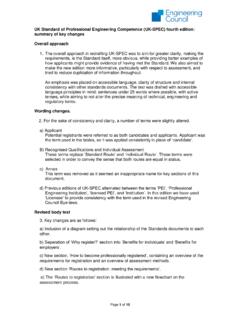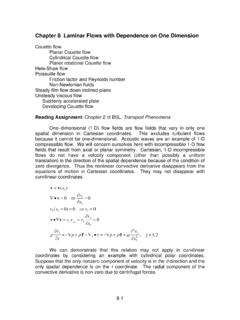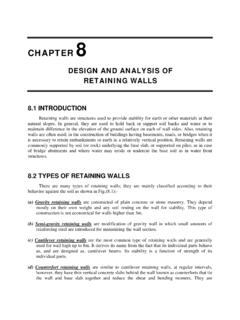Transcription of Mass Transfer - ceng.tu.edu.iq
1 Tikrit University Chemical Engineering Department Mass Transfer Third Year By Assist. Prof. Dr. Ahmed Daham Mass Transfer Third Year Assist. Prof. Dr. Ahmed Daham 2 Title: Mass Transfer Course Instructor: Assist. Prof. Dr. Ahmed Daham Wiheeb Textbook: 1. Coulson & Richardson , Chemical Engineering, Volume 1, six edition, ELBS, Pergamon Press. 2002. 2. Coulson & Richardson , Chemical Engineering, Volume 2, fifth edition, ELBS, Pergamon Press. 2002. References: 1. Treybal , Mass Transfer Operations, McGraw Hill 2. McCabe , Smith & Harriott P., Unit Operations in Chemical Engineering, McGraw Hill. 3. Seader Henley , Separation Process Principles. 4. Rousseau , Handbook of Separation Process Technology, John Wiley 5. Foust et al, Principles of Unit Operations, John Wiley Course description: This course covers the fundamentals of the basic concepts of mass transport and understanding about diffusion theory, gas absorption, liquid-liquid extraction, leaching , distillation, humidification, drying and evaporation.
2 Objectives: To give the students a application of diffusion theory to simple mass Transfer problems. Analysis of chemical engineering unit operations involving mass Transfer . Design principles for mass Transfer equipment. Solids/Liquids separation processes. liquids/Liquids separation processes. gases/Liquids separation processes. Grading: No. Assessment Number % each % total Dates 1 Homework (HW), Quizzes(Q) 10 % 10 2 Test 1 1 % 3 Test 2 1 % 4 Test 3 1 % 5 Test 4 1 % 6 Final Exam (F) 1 60 % 60 Overall Total 100 Mass Transfer Third Year Assist. Prof. Dr. Ahmed Daham 3 Syllabus: No Topic Hours 1 Diffusion , flick's law, modes of diffusion 4 2 Multi-components mixture, correction of diffusivity 4 3 Diffusion in varying cross section area 4 4 Diffusivity coefficient in liquid and gas 2 5 Mass Transfer theory 2 6 Mass Transfer coefficient, wetted wall column 4 7 Absorption, equilibrium of gas and liquid 4 8 Packed tower 6 9 Tray tower 6 10 Calculation of tower diameter, stripping 2 11 Extraction , differential type 4 12 Completely immiscible 4 13 Party miscible 4 14 Leaching, batch leaching 4 15 Continuous leaching, constant under flow 4 16 Continuous leaching, variable under flow 4 17 Distillation , vapor-liquid equilibrium 4 18 Differential type 2 19 flash distillation 2 20 Continuous distillation (binary system)
3 6 21 Calculation the number of stages and reflux ration in continuous distillation 4 22 Multi-feeds and side stream , lewis sorial method 6 23 Ponchon-savarit method 4 24 Batch distillation with constant reflux ratio 6 and with constant product composition 25 Multi-component distillation 4 26 Humidification , humidity 2 27 Cooling tower calculation 2 28 Height of cooling tower, carey method 4 29 Drying process 6 30 Evaporation 4 Mass Transfer Third Year Assist. Prof. Dr. Ahmed Daham 4 Chapter (10) in Volume (1) ((Diffusion)) The term diffusion (mass Transfer ) is used to denote the transference of a component in a mixture from a region where its concentration is high to a region where the concentration is lower. Diffusion process can take place in a gas or vapour or in a liquid, and it can result from the random velocities of the molecules (molecular diffusion) or from the circulating or eddy currents present in a turbulent fluid (eddy diffusion).
4 Diffusion depends on: 1. Driving force ( C), moles per unit volume (kmol/m3). 2. The distance in the direction of Transfer ( z), meter (m). 3. Diffusivity coefficient, unit area per unit time (m2/s). Fick's Law of diffusion: The rate of diffusion is governed by Fick's Law, first proposed by Fick in 1855 which expresses the mass Transfer rate as a linear function of the molar concentration gradient. In a mixture of two gases A and B, assumed ideal, Fick's Law for steady state diffusion may be written as: Mass Transfer Third Year Assist. Prof. Dr. Ahmed Daham 5 JA CA z JA= DAB dCAdz .. Fick s first law of steady state diffusion Where: JA: is the molecular diffusion flux of A , (moles per unit area per unit time) . CA: is the concentration of A (moles of A per unit volume) kmolm3.
5 DAB: is known as the diffusivity or diffusion coefficient for A in B (unit area per unit time) m2s z: is distance in the direction of Transfer (m). Diffusion with bulk of mass in motion: The Fick's first law of diffusion describes the mass Transfer from the random movement of molecules of a stationary medium or a fluid in streamline flow. If circulating currents or eddies are present, then the molecular mechanism will be reinforced and the total mass Transfer rate may be written as: Total diffusion = Molecular diffusion + Convection term Convection term = Eddy diffusion = Molar flux due to convection Convection term = Concentration * mass Transfer velocity = CA . V Where: = = + = . = Total diffusion = NA = JA + CA . V = + +.
6 ( ) Total diffusion equation in the form of concentration (normally used for liquids) Mass Transfer Third Year Assist. Prof. Dr. Ahmed Daham 6 The total diffusion equation can be write in another forms: a. Partial pressure for gases. b. Mole fraction for gases and liquids. a. Total diffusion equation in the partial pressure form: If A and B are ideal gases in a mixture, the ideal gas law may be applied to each gas separately and to the mixture: P V=n R T P =n V R T P =C R T PA =CA R T and PT =CT R T CA=PAR T dCA=1R T dPA = + + ..( ) Total diffusion equation in the form of partial pressure (normally used for gases) b. Total diffusion equation in the mole fraction form: XA=PAPT or XA=CACT PT XA=PA and CT XA=CA PT dXA=dPA and CT dXA=dCA Then: = + +.
7 ( ) Total diffusion equation in the form of mole fraction (used for gases and liquids) Mass Transfer Third Year Assist. Prof. Dr. Ahmed Daham 7 ((i ((ii ((1 ((2 Modes of diffusion There are two modes of diffusion: 1. Stagnant diffusion (Mass Transfer through a stationary second component): In several important processes, one component in a gaseous mixture will be transported relative to a fixed plane, such as a liquid interface, for example, and the other will undergo no net movement. In gas absorption a soluble gas A is transferred to the liquid surface where it dissolves, whereas the insoluble gas B undergoes no net movement with respect to the interface. Similarly, in evaporation from a free surface, the vapour moves away from the surface but the air has no net movement.))))))))
8 The mass Transfer process therefore: = + + ..(1) Since stagnant diffusion layer: NB = 0 = Stagnant diffusion In absorption process Diffusion Counter diffusion = Unequimolecular Counter diffusion In chemical reaction = Equimolecular Counter diffusion In distillation column Mass Transfer Third Year Assist. Prof. Dr. Ahmed Daham 8 = + ..(2) = ..(3) = ..(4) = ..(5) = Example : Ammonia gas is diffusing at a constant rate through a layer of stagnant air 1 mm thick.
9 Conditions are such that the gas contains 50 percent by volume ammonia at one boundary of the stagnant layer. The ammonia diffusing to the other boundary is quickly absorbed and the concentration is negligible at that plane. The temperature is 295 K and the pressure atmospheric, and under these conditions the diffusivity of ammonia in air is cm2/s. Estimate the rate of diffusion of ammonia through the layer. Solution: If the subscripts 1 and 2 refer to the two sides of the stagnant layer and the subscripts A and B refer to ammonia and air respectively, then the rate of diffusion through a stagnant layer is given by: = Where: = kPa , =0 , =yA PT = kPa = =1 mm=1 10 3 m = kJkmol . K , =298 K and DAB= 2 = 10 5 2 Mass Transfer Third Year Assist.
10 Prof. Dr. Ahmed Daham 9 = 10 295 10 3 ln = 10 4 2. Counter diffusion: i. Equimolecular counter diffusion: When the mass Transfer rates of the two components are equal and opposite the process is said to be one of equimolecular counter diffusion. Such a process occurs in the case of the box with a movable partition. It occurs also in a distillation column when the molar latent heats of the two components are the same ( A = B) . At any point in the column a falling stream of liquid is brought into contact with a rising stream of vapour with which it is not in equilibrium. The less volatile component is transferred from the vapour to the liquid and the more volatile component is transferred in the opposite direction. If the molar latent heats of the components are equal, the condensation of a given amount of less volatile component releases exactly the amount of latent heat required to volatilize the same molar quantity of the more volatile component.
